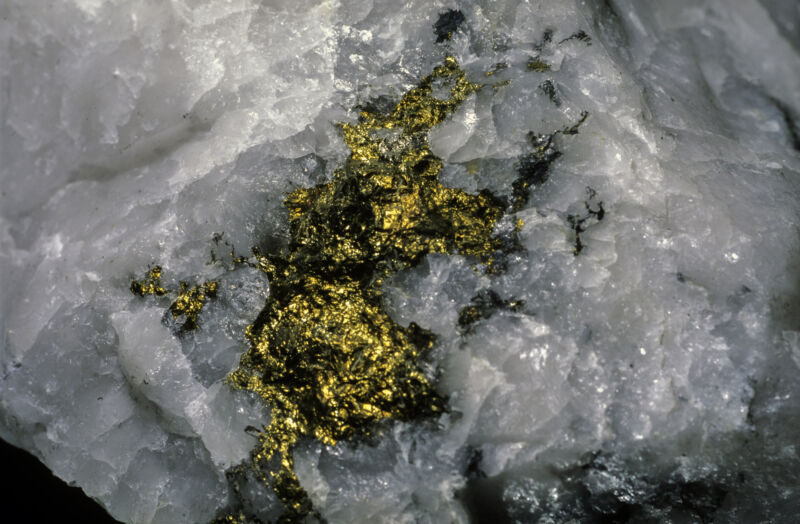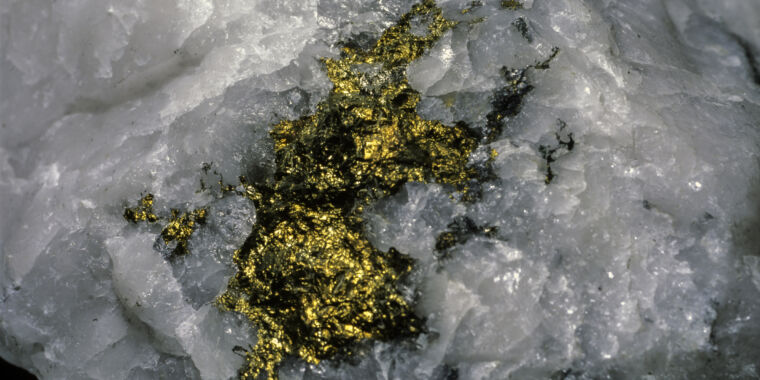Natural piezoelectric effect may build gold deposits
Building the bling —
How does an unreactive, barely soluble metal end up forming giant chunks?

Enlarge / A lot of gold deposits are found embedded in quartz crystals.
One of the reasons gold is so valuable is because it is highly unreactive—if you make something out of gold, it keeps its lustrous radiance. Even when you can react it with another material, it’s also barely soluble, a combination that makes it difficult to purify away from other materials. Which is part of why a large majority of the gold we’ve obtained comes from deposits where it is present in large chunks, some of them reaching hundreds of kilograms.
Those of you paying careful attention to the previous paragraph may have noticed a problem here: If gold is so difficult to get into its pure form, how do natural processes create enormous chunks of it? On Monday, a group of Australian researchers published a hypothesis, and a bit of evidence supporting it. They propose that an earthquake-triggered piezoelectric effect essentially electroplates gold onto quartz crystals.
The hypothesis
Approximately 75 percent of the gold humanity has obtained has come from what are called orogenic gold deposits. Orogeny is a term for the tectonic processes that build mountains, and orogenic gold deposits form in the seams where two bodies of rock are moving past each other. These areas are often filled with hot hydrothermal fluids, and the heat can increase the solubility of gold from “barely there” to “extremely low,” meaning generally less than a single milligram in a liter of water.
The other striking thing about these deposits is that they’re generally associated with the mineral quartz, a crystalline form of silicon dioxide. And that fact formed the foundation for the new hypothesis, which brings together a number of topics that are generally considered largely unrelated.
It turns out that quartz is the only abundant mineral that’s piezoelectric, meaning that it generates a charge when it’s placed under strain. While you don’t need to understand why that’s the case to follow this hypothesis, the researchers’ explanation of the piezoelectric effect is remarkably cogent and clear, so I’ll just quote it here for people who want to come away from this having learned something: “Quartz is the only common mineral that forms crystals lacking a center of symmetry (non-centrosymmetric). Non-centrosymmetric crystals distorted under stress have an imbalance in their internal electric configuration, which produces an electrical potential—or voltage—across the crystal that is directly proportional to the applied mechanical force.”
Quartz happens to be an insulator, so this electric potential doesn’t easily dissipate on its own. It can, however, be eliminated through the transfer of electrons to or from any materials that touch the quartz crystals, including fluids. In practice, that means the charge can drive redox (reduction/oxidation) reactions in any nearby fluids, potentially neutralizing any dissolved ions and causing them to come out of solution.
This has the potential to be self-reinforcing. Once a small metal deposit forms on the surface of quartz, it will ease the exchange of electrons with the fluid in its immediate vicinity, meaning more metal will be deposited in the same location. This will also lower the concentration of the metal in the nearby solution, which will favor the diffusion of additional metal ions into the location, meaning that the fluid itself doesn’t need to keep circulating past the same spot.
Finally, the concept also needs a source of strain to generate the piezoelectric effect in the first place. But remember that this is all happening in an active fault zone, so strain is not in short supply.
And the evidence
Figuring out whether this happens in active fault zones would be extremely challenging for all sorts of reasons. But it’s relatively easy to dunk some quartz crystals in a solution containing gold and see what happens. So the latter is the route the Australians took.
The gold came in the form of either a solution of gold chloride ions or a suspension of gold nanoparticles. Quartz crystals were either pure quartz or obtained from a gold-rich area and already contained some small gold deposits. The crystals themselves were subject to strain at a frequency similar to that produced by small earthquakes, and the experiment was left to run for an hour.
An hour was enough to get small gold deposits to form on the pure quartz crystals, regardless of whether it was from dissolved gold or suspended gold nanoparticles. In the case of the naturally formed quartz, the gold ended up being deposited on the existing sites where gold metal is present, rather than forming additional deposits.
The researchers note that a lot of the quartz in deposits is disordered rather than in the form of single crystals. In disordered material, there are lots of small crystals oriented randomly, meaning the piezoelectric effect of any one of these crystals is typically canceled out by its neighbors. So, gold will preferentially form on single crystals, which also helps explain why it’s found in large lumps in these deposits.
So, this is a pretty compelling hypothesis—it explains something puzzling, relies on well-established processes, and has a bit of experimental support. Given that activity in active faults is likely to remain both slow and inaccessible, the next steps are probably going to involve getting longer-term information on the rate of deposition through this process and a physical comparison of these deposits with those found in natural settings.
Nature Geoscience, 2024. DOI: 10.1038/s41561-024-01514-1 (About DOIs).
Natural piezoelectric effect may build gold deposits Read More »
